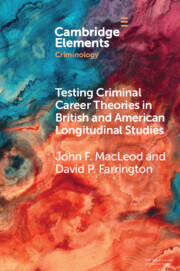Element contents
Testing Criminal Career Theories in British and American Longitudinal Studies
Published online by Cambridge University Press: 17 June 2022
Summary
- Type
- Element
- Information
- Series: Elements in CriminologyOnline ISBN: 9781009039628Publisher: Cambridge University PressPrint publication: 07 July 2022
References
- 6
- Cited by



